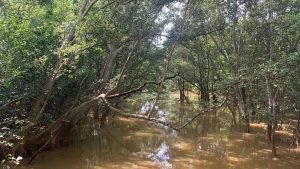Mangroves, a crown jewel of Singapore’s coastline
July 27, 2021

In the recent commentary ‘Mangroves, a crown jewel of Singapore’s coastline’ (Channel News Asia), Associate Professor Daniel Friess (NUS Department of Geography) expounds on the importance of mangroves towards coastal communities such as Singapore.
Singapore’s mangroves are some of the most biodiverse in the world. They play a key role in mitigating climate change, due to their abilities to trap heavy metals and pharmaceutical products in their soils, as well as suck up carbon dioxide from the atmosphere. Not only that, mangroves can also facilitate climate change adaptation and coastal protection. Mangroves protect shorelines and the assets behind them during large storms as they can absorb more than 75 percent of the energy of incoming waves. They are also able to trap floating sediment which may potentially allow them to keep pace with the rate of rising sea levels.
Where mangroves were once considered one of the most threatened habitats of the world, rates of mangrove loss have reduced dramatically due to efforts by the international community. However, between 1958 and 2014, the land which mangroves occupied in Singapore declined by more than 80 percent due to land reclamation and damming. It was only until the late 1980s when more light was shed on the importance of mangroves in Singapore and 87 hectares of land was designated as the Sungei Buloh Nature Park. In 2002, the area was gazetted to be a nature reserve and renamed Sungei Buloh Wetland Reserve.
The newly announced Sungei Buloh Nature Park Network will be triple the size of the current Sungei Buloh Wetland Reserve. Other mangrove areas such as Mandai Mangrove, Mudflat Nature Park, and Lim Chu Kang Nature Park will be subsumed under this network.
A/P Friess asserts that there are many opportunities to restore mangroves beyond preserving the mangrove areas which already exist. We can also bring back the mangroves which were previously lost. For example, 13 hectares of mangroves were replaced after previously being lost to reclamation works on Pulau Semakau. Novel hybrid engineering solutions such as incorporating mangrove saplings into coastal defence structures can simultaneously contribute towards mangrove restoration and reduce the resources needed for building man-made defences. The restoration of abandoned aquaculture ponds across Singapore could also increase Singapore’s national mangrove areas by as much as 10 percent.
According to the Urban Redevelopment Authority’s 2019 Master Plan, some mangrove areas still face the threat of land reclamation. Furthermore, though mangroves can help protect us from sea-level rise, they also wind up heavily affected during this process. Therefore, A/P Friess argues that we should alleviate some of the human pressures mangroves face so that they can stand a greater chance against climate change.
Today, mangroves are considered an integral nature-based solution to coastal protection and climate change adaptation. Though there exist challenges to the continued preservation of mangroves, there is a strong foundation based on previous efforts to save mangroves upon which to build future conservation successes.
Read the article here.
